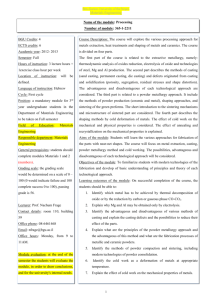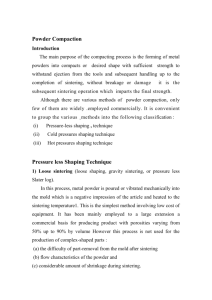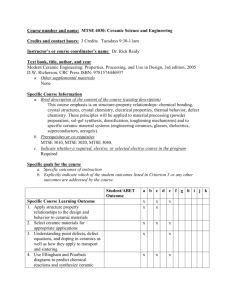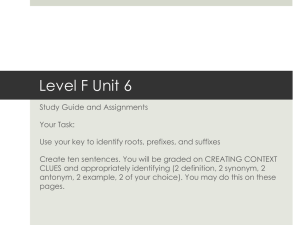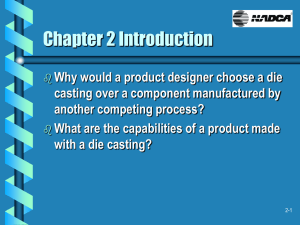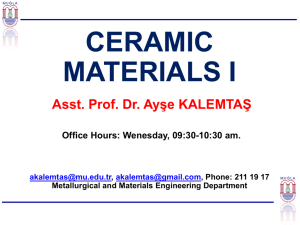Raw materials and their characterization
advertisement
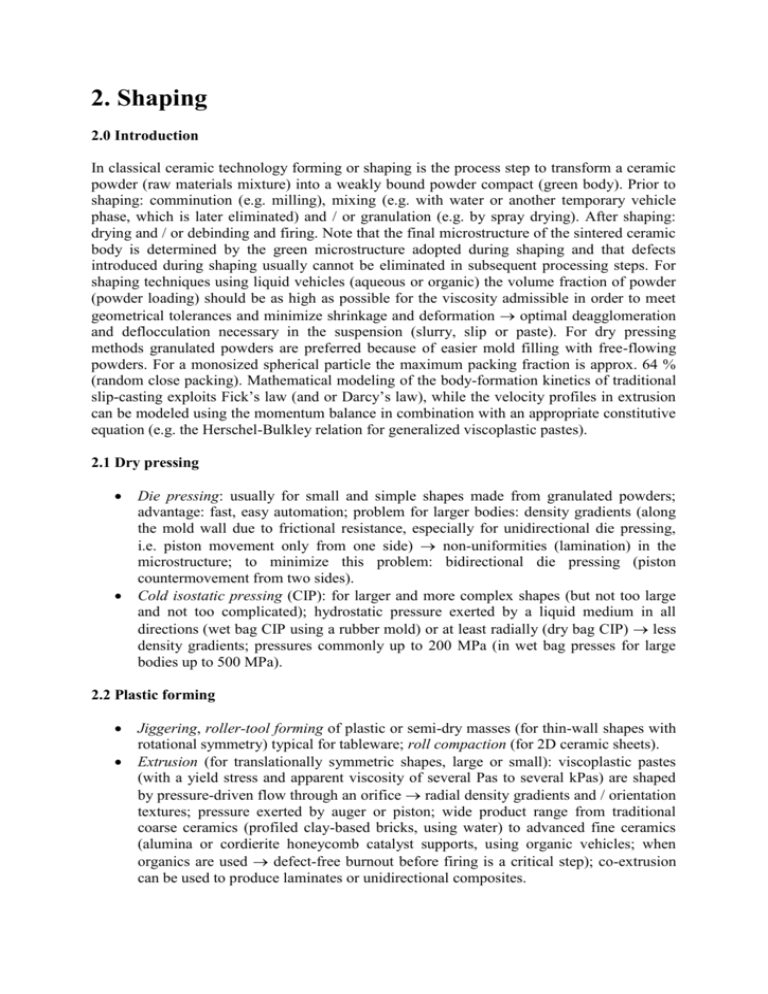
2. Shaping 2.0 Introduction In classical ceramic technology forming or shaping is the process step to transform a ceramic powder (raw materials mixture) into a weakly bound powder compact (green body). Prior to shaping: comminution (e.g. milling), mixing (e.g. with water or another temporary vehicle phase, which is later eliminated) and / or granulation (e.g. by spray drying). After shaping: drying and / or debinding and firing. Note that the final microstructure of the sintered ceramic body is determined by the green microstructure adopted during shaping and that defects introduced during shaping usually cannot be eliminated in subsequent processing steps. For shaping techniques using liquid vehicles (aqueous or organic) the volume fraction of powder (powder loading) should be as high as possible for the viscosity admissible in order to meet geometrical tolerances and minimize shrinkage and deformation optimal deagglomeration and deflocculation necessary in the suspension (slurry, slip or paste). For dry pressing methods granulated powders are preferred because of easier mold filling with free-flowing powders. For a monosized spherical particle the maximum packing fraction is approx. 64 % (random close packing). Mathematical modeling of the body-formation kinetics of traditional slip-casting exploits Fick’s law (and or Darcy’s law), while the velocity profiles in extrusion can be modeled using the momentum balance in combination with an appropriate constitutive equation (e.g. the Herschel-Bulkley relation for generalized viscoplastic pastes). 2.1 Dry pressing Die pressing: usually for small and simple shapes made from granulated powders; advantage: fast, easy automation; problem for larger bodies: density gradients (along the mold wall due to frictional resistance, especially for unidirectional die pressing, i.e. piston movement only from one side) non-uniformities (lamination) in the microstructure; to minimize this problem: bidirectional die pressing (piston countermovement from two sides). Cold isostatic pressing (CIP): for larger and more complex shapes (but not too large and not too complicated); hydrostatic pressure exerted by a liquid medium in all directions (wet bag CIP using a rubber mold) or at least radially (dry bag CIP) less density gradients; pressures commonly up to 200 MPa (in wet bag presses for large bodies up to 500 MPa). 2.2 Plastic forming Jiggering, roller-tool forming of plastic or semi-dry masses (for thin-wall shapes with rotational symmetry) typical for tableware; roll compaction (for 2D ceramic sheets). Extrusion (for translationally symmetric shapes, large or small): viscoplastic pastes (with a yield stress and apparent viscosity of several Pas to several kPas) are shaped by pressure-driven flow through an orifice radial density gradients and / orientation textures; pressure exerted by auger or piston; wide product range from traditional coarse ceramics (profiled clay-based bricks, using water) to advanced fine ceramics (alumina or cordierite honeycomb catalyst supports, using organic vehicles; when organics are used defect-free burnout before firing is a critical step); co-extrusion can be used to produce laminates or unidirectional composites. Injection molding (for small parts with complex geometries): ceramic powder feedstock with binder (usually polymer- or wax-based); upon heating the binder liquefies; after mold filling (injection) the binder solidifies green part can be ejected (but requires sufficiently slow binder burnout before sintering, usually in the temperature range 300–700 °C; this processing step is size-limiting); capital-expensive technique (economically useful only for mass production); hot molding (low-pressure variant of injection molding for feedstocks with lower apparent viscosity). 2.3 Casting techniques Slip casting and pressure slip-casting (preferentially for thin-walled bodies, large or small): body formation by dewatering (drainage) of highly fluid slips (apparent viscosity < 500 mPas) across a semipermeable mold wall (plaster or porous polymer); body formation kinetics obey a square-root-of-time law microstructural gradients are possible from the body interior to the wall. The related techniques centrifugal casting and electrophoretic deposition usually exhibit enhanced density gradients and can be applied to produce functionally graded materials using a slip-casting approach. Gel casting and related techniques, e.g. direct coagulation casting (DCC) use a (thermally or chemically induced) in-situ phase transition (e.g. a gelling transition) of an organic or water-based vehicle and enables casting of suspensions into non-porous molds (e.g. metal molds) uniform (i.e. gradient-free) microstructure; a similar process is starch consolidation casting (SCC), based on the ability of starch to swell in water at elevated temperature (starch used as a pore-forming and body-forming agent). Tape casting (typical thickness several hundred µm): ceramic suspension (containing binder, plasticizer, solvents and functional additives) deposited on a flat carrier substrate, results in 2D ceramic sheets after firing (e.g. for multilayer capacitors). 2.4 Other techniques Hot pressing: compaction and sintering of green bodies at the same time; mechanical pressure > 20 MPa increases the driving force for densification (by acting against the internal pore pressure) without increasing the driving force for grain growth reduced sintering temperature to achieve high density and fine grain size; commonly used to sinter high-purity products normally requiring high sintering temperatures and / or sintering additives (which would deteriorate properties). Hot isostatic pressing (HIP): pressure 10–200 MPa exerted by hot pressurized gas; product size should not be too large, product shape should not be too complicated; can also be used as a post-sintering technique to reduce the size of closed pores; expensive technique (useful only for high-value products designed for demanding applications). Complex exercise problem: Discuss the results of mathematical modeling of extrusion processes for composite ceramics (particulate-, platelet- and fiber/whisker-reinforced) in relation to the evolving microstructure, with special regard to particle shape. Further, discuss the question of microstructural uniformity in other shaping processes, especially in the new shaping methods gel casting and starch consolidation casting. Additional explicit questions: a.) What is the underlying reason for microstructural non-uniformity in extrusion processes ? Make a clear distinction between material and process parameters. b.) How can texture effects generally be avoided ? By what methods can anisotropic or non-uniform (functionally graded) ceramics be produced ?
